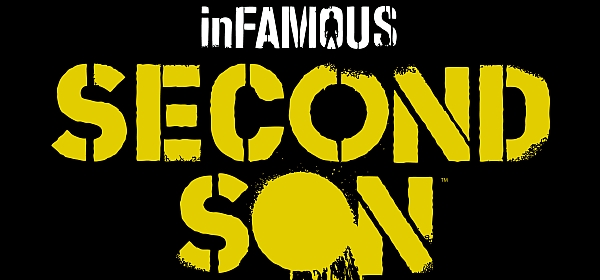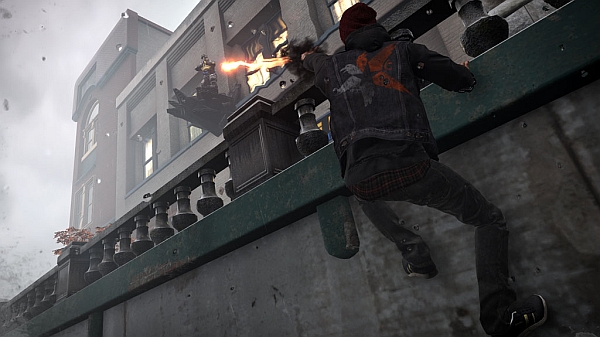
The InFamous series, like many superhero simulations before it, is at its best when the player is made to feel like a 24-carat badass. InFamous: Second Son is possibly the epitome of this feeling. However, after experiencing that same feeling in the two (and a half) previous games in the series, alongside numerous other titles of their ilk, the effect is diminished.
Platforms: PS4
Publisher: Sony Computer Entertainment
Developer: Sucker Punch Productions
Genre: Moral Alignment Quiz
Release Date: March 21, 2014
ESRB Rating: Teen
The narrative setup serves to heighten this meteoric rise to superhero power. Just seven years after the death of Cole McGrath at the end of InFamous 2, the government has set up the Department of Unified Protection (DUP) to capture and round up Conduits. Conduits, by the way, are those who have latent special abilities that can be unlocked. The government has re-branded the Conduits as “Bio-Terrorists” to make people more afraid of them. Enter new player character, Delsin Rowe: small town boy, graffiti artist, and general delinquent. One day, some “Bio-Terrorists” stage a prison break. Delsin grabs one of the escapees and discovers that he, too, is a Conduit. Realizing he can absorb the powers of other Conduits, Delsin sets out to find some other powers and take down the all-controlling DUP and their boss, Brooke Augustine.
As you make your way through the linear story missions, new skills and powers are slowly drip-fed to the player. Over the 12-15 hour campaign, you are given a new power every couple of hours, with more than a handful of power-specific abilities – and upgrades to them – doled out with open-world collectibles. It’s a perfect way of doing things: a slow build towards supreme superpower. Not only does it help Delsin on his character arc to becoming a goodie or a baddie, it also works on the player on a psychological level by letting them grow slowly into Delsin. Trust me when I say that by the end of my first playthrough, I more often that not wanted to burst out in maniacal laughter after pulling off a series of sweet moves and removing a swathe of enemies from an area.
The team at Sucker Punch has managed to produce a miracle by having each power feel incredibly different while controlling exactly the same. Each power procured by Delsin, from smoke to concrete, is simple at its base level. L2 aims your power and R2 shoots, L1 sends out a stun, R1 a missile, and Circle is your dash. As each power unlocks, they slowly get more complicated and powerful, helping in the transition from serfdom to supremacy. Each ability set feels different than the others as well. Each bullet or rocket deals differing damage and has a differing area of effect. You can jump and float, but some powers let you float longer than others. Even the dash, which also helps you weave and dodge in combat, has the range of a short burst to an extended run, depending on how far you’ve unlocked it in your power tree.

There is a fantastic portion of Seattle for you to explore during and between missions. Sucker Punch even went as far as licensing local landmarks and businesses to give the open world a more realistic feel. That sounds rather stupid and obvious, but it helps in pushing that superhero feeling beyond how it felt in the invented setting of, say, Empire City. Simple acts like scaling the Space Needle or sucking neon from the Sub Pop sign are far more memorable than the generic New York-looking apartment buildings of the first game. Second Son looks almost unreal, from beautiful sunsets down to individually waggling fingers. The particle effects when Delsin drains powers from the environment still stagger me every time I see it. However, and disappointingly so, apart from those memorable Seattle beacons, much of the city blends into itself.
To keep yourself busy during downtime, Second Son challenges you to take down the Department of Unified Protection across the city. You’ll be tasked to find hidden audio logs and cameras, as well as take out every level of the DUP, from uncovering secret agents to blasting hand-scanning checkpoints and entire fortified structures. My favourite side tasks are the graffiti ones, and not because I really enjoyed Mark Ecko’s Getting Up, either. Not only does it show off Delsin’s inherently cocky and criminalistic personality, but it is also possibly the most ingenious use of the DualShock 4’s motion control to date. There is a certain completionist urge that I can’t help but have when looking at the map. Slowly moving from one end to the other knocking out objectives is hugely satisfying. Not only that, but the more side missions you complete, the more blast shards you collect, and the more powerful you then become.
Sadly, and as fun as they are, the majority of gameplay elements in InFamous: Second Son feel very much firmly rooted in the PlayStation 3 era. With the metaphorical passing of the torch from 3 to 4, I expected more from the moment-to-moment gameplay in Second Son. The game just doesn’t deliver many next-generation moments, which is disappointing. I’ve been a fan of the InFamous franchise since day one, but Second Son is likely the last entry for me as the series has become rote. The new characters and setting help, but not bringing in a single plot thread from the series canon detracted from my experience. However, just like how you choose your in-game morality, it is all a matter of perspective. InFamous: Second Son can be a complete blast to play through, though it’s often not.

Review Disclosure: A retail copy of InFamous: Second Son was purchased by Warp Zoned for the purposes of this review.







